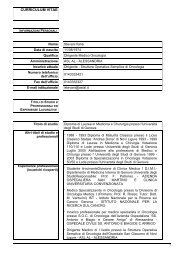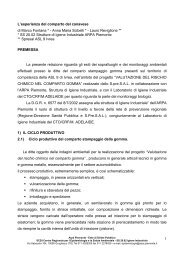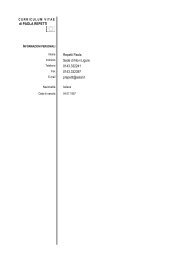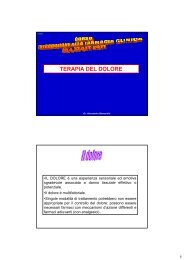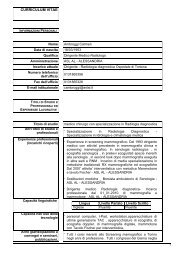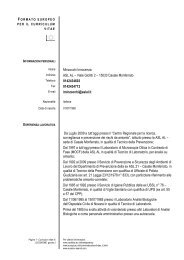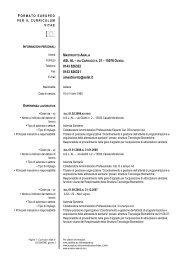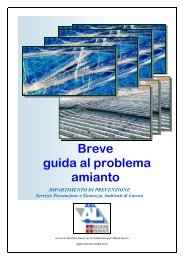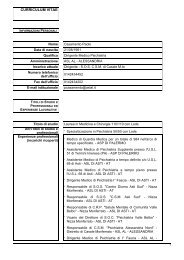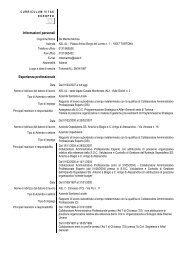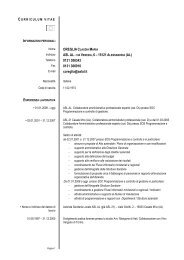il ruolo cardine del medico di medicina generale - ASL AL
il ruolo cardine del medico di medicina generale - ASL AL
il ruolo cardine del medico di medicina generale - ASL AL
You also want an ePaper? Increase the reach of your titles
YUMPU automatically turns print PDFs into web optimized ePapers that Google loves.
IL PERCORSO DEL PAZIENTE ONCOLOGICO ANZIANO<br />
IL RUOLO CARDINE DEL MEDICO DI<br />
MEDICINA GENER<strong>AL</strong>E<br />
DR.CLAUDIO AGOSTO<br />
MEDICO MEDICINA GENER<strong>AL</strong>E<br />
MEDICINA SPECI<strong>AL</strong>ISTICA E MEDICINA GENER<strong>AL</strong>E<br />
DIFFERENTE APPROCCIO <strong>AL</strong> PROBLEMA<br />
SPECI<strong>AL</strong>ISTA: prevalente cura <strong>del</strong>la malattia<br />
MEDICO MEDICINA GENER<strong>AL</strong>E: prevalente cura <strong>del</strong>la persona nella<br />
sua interezza<br />
Passaggio da un approccio prevalentemente/esclusivamente d'organo ad<br />
una visione olistica.<br />
Ruoli non contrapposti ma complementari nell'interesse <strong>del</strong> paziente<br />
Concetto valido sempre, ma particolarmente nell'anziano
RAPPORTO ISTAT 2007: SOGGETTI<br />
ULTRASESSANTACINQUENNI<br />
40%: una malattia cronica<br />
18%: limitazioni funzionali nelle attività <strong>del</strong>la vita quoti<strong>di</strong>ana<br />
(<strong>di</strong>sab<strong>il</strong>ità) <strong>di</strong> cui:<br />
* 68%: almeno 3 malattie croniche<br />
* 8% confinato in casa<br />
→ all'avanzare <strong>del</strong>l'età si collega <strong>il</strong> concetto <strong>di</strong> FRAGILITA': maggior<br />
vulnerab<strong>il</strong>ità allo stress, limitazione dovuta alla presenza <strong>di</strong><br />
polipatologie e un deterioramento <strong>del</strong>la salute e <strong>del</strong>lo stato funzionale<br />
che pre<strong>di</strong>spone ad esiti negativi → necessità ancora più impellente <strong>di</strong><br />
un approccio per molti versi <strong>di</strong>verso da quello tra<strong>di</strong>zionale e<br />
totalmente in<strong>di</strong>vidualizzato.<br />
INVECCHIAMENTO<br />
L'INVECCHIAMENTO non è una malattia, non è preve<strong>di</strong>b<strong>il</strong>e né<br />
curab<strong>il</strong>e, pertanto vi può essere un invecchiamento “NORM<strong>AL</strong>E” ed<br />
un invecchiamento “PATOLOGICO” associato alla presenza <strong>di</strong> più<br />
problematiche.<br />
L'aspettativa <strong>di</strong> vita ha consentito ad una parte degli anziani <strong>di</strong><br />
raggiungere un'età avanzata in buone con<strong>di</strong>zioni <strong>di</strong> salute, ma ha<br />
determinato anche una crescita <strong>del</strong> n°<strong>di</strong> anziani affetti da malattie<br />
croniche e <strong>di</strong>sab<strong>il</strong>ità.<br />
AMPIO SPETTRO: dall'invecchiamento “DI SUCCESSO” (definizione<br />
OMS per gli anziani che conservano fino alla fine dei loro giorni una<br />
capacità funzionale che consente loro una vita autonoma e priva <strong>di</strong><br />
<strong>di</strong>sab<strong>il</strong>ità), NORM<strong>AL</strong>E, PATOLOGICO fino alla FRAGILITA'.
V<strong>AL</strong>UTAZIONE DELL'ANZIANO<br />
QUINDI:<br />
Con <strong>il</strong> paziente anziano si rende necessario <strong>il</strong> superamento <strong>del</strong><br />
tra<strong>di</strong>zionale approccio <strong>me<strong>di</strong>co</strong> concentrandosi su una<br />
V<strong>AL</strong>UTAZONE OLISTICA e MULTIDIMENSION<strong>AL</strong>E centrata<br />
sulla persona, che consideri la totalità e la complessità <strong>del</strong> paziente<br />
geriatrico, valutandone lo stato cognitivo, la funzionalità fisica, <strong>il</strong><br />
tono <strong>del</strong>l'umore, le con<strong>di</strong>zioni fam<strong>il</strong>iari, socioeconomiche e culturali.<br />
Questo approccio è fondamentale per personalizzare <strong>il</strong> percorso <strong>di</strong> cura<br />
ed evitare sia SOVRATRATTAMENTI (fino all'estremo<br />
<strong>del</strong>l'accanimento) sia SOTTOTRATTAMENTI (fino all'estremo<br />
<strong>del</strong>l'ageismo)<br />
RETI ONCOLOGICHE E CURE PRIMARIE<br />
La prevalenza <strong>di</strong> persone con una <strong>di</strong>agnosi <strong>di</strong> cancro nel corso <strong>del</strong>la vita<br />
è in continuo aumento.<br />
L'aumento <strong>del</strong>la prevalenza è legato a vari fattori:<br />
1) invecchiamento <strong>del</strong>la popolazione (2/3 > 65 anni)<br />
2) riduzione mortalità specifica<br />
3) allungamento fase <strong>di</strong> sopravvivenza<br />
Quin<strong>di</strong>: per ogni paziente si allunga <strong>il</strong> tempo <strong>di</strong> assistenza, sud<strong>di</strong>viso,<br />
schematizzando, in una I FASE in cui l'obiettivo è la sopravvivenza<br />
ed in cui si inseriscono prevalentemente le cure Oncologiche e <strong>il</strong><br />
Follow – Up ed una possib<strong>il</strong>e II FASE in cui l'obiettivo <strong>di</strong>venta la<br />
qualità <strong>di</strong> vita fino ad arrivare alle Cure Palliative.
NECESSITA' DELLA RETE<br />
“ Una <strong>del</strong>le criticità maggiormente evidenziate dai citta<strong>di</strong>ni<br />
nell'accesso ai Servizi Sanitari è l'insufficienza <strong>di</strong> continuità<br />
<strong>del</strong>le cure, ovvero <strong>il</strong> vuoto assistenziale, talora percepito come<br />
abbandono, quando per le cure sono necessari molteplici<br />
interlocutori o <strong>di</strong>verse modalità assistenziali”<br />
(da Documento Finale Gruppo <strong>di</strong> Lavoro Continuità Assistenziale Reg.<br />
Lombar<strong>di</strong>a 30/01/2007).<br />
→ quin<strong>di</strong> necessità <strong>di</strong> una RETE come strumento <strong>di</strong> gestione per<br />
raggiungere una Continuità Assistenziale.<br />
RETE E CONTINUITA'<br />
ASSISTENZI<strong>AL</strong>E<br />
La Rete è una modalità organizzativa che premia e valorizza la<br />
professionalità, la storia <strong>del</strong>le persone e le loro competenze<br />
La principale finalità <strong>del</strong>la Rete è quella <strong>di</strong> garantire al citta<strong>di</strong>no <strong>il</strong><br />
complesso ed articolato processo <strong>del</strong>la Continuità <strong>del</strong>le Cure, per cui<br />
le Reti debbono superare l'orizzonte <strong>di</strong> interesse selettivo solo alla<br />
patologia in sé riconoscendo che <strong>il</strong> soggetto <strong>di</strong> cui “prendersi carico”<br />
è la persona (riconoscimento dei bisogni <strong>di</strong>versi <strong>di</strong> ogni pz.)<br />
E' necessario “misurare” l'impatto <strong>del</strong>la Rete sulla qualità <strong>del</strong>le cure e<br />
non da ultimo i costi. Un buon in<strong>di</strong>catore è valutare i cambiamenti <strong>di</strong><br />
comportamento dei singoli Operatori.<br />
(Dr. Lora Apr<strong>il</strong>e, Congresso SIMG 2010)
MEDICO DI MEDICINA GENER<strong>AL</strong>E E PAZIENTE<br />
ONCOLOGICO<br />
Un MMG con 1500 deve aspettarsi <strong>di</strong> avere nella sua vita lavorativa ><br />
100 assistiti con dg <strong>di</strong> cancro.<br />
Possib<strong>il</strong>e sud<strong>di</strong>visione rispetto alla malattia:<br />
* guariti, con necessità <strong>di</strong> controlli perio<strong>di</strong>ci<br />
* in terapia <strong>di</strong> prevenzione (ad esempio, donne con ca mammella in<br />
terapia ormonale)<br />
* con malattia attiva, in terapia<br />
* con malattia avanzata (cure palliative)<br />
MEDICO DI MEDICINA GENER<strong>AL</strong>E E PAZIENTE<br />
ONCOLOGICO<br />
I sottogruppi sud<strong>di</strong>visi in base alla malattia sono omogenei<br />
In realtà, all'interno <strong>di</strong> ogni sottogruppo ogni pz. ha avuto ed ha bisogni<br />
<strong>di</strong>versi da parte <strong>del</strong> MMG.<br />
I “guariti” , ad esempio, non sono una classe omogenea <strong>di</strong> persone:<br />
abbiamo una traccia comune per tutti (i controlli perio<strong>di</strong>ci), ma poi<br />
tutto cambia in rapporto all'età <strong>del</strong>la persona, alle sue aspettative, alla<br />
sua visione e f<strong>il</strong>osofia <strong>di</strong> vita, ai suoi valori morali, religiosi, alla<br />
comorbi<strong>di</strong>tà, al grado <strong>di</strong> funzionalità ecc.<br />
ANZIANI: spesso hanno molti altri problemi e non soltanto <strong>di</strong> tipo<br />
sanitario, ma anche <strong>di</strong> tipo sociale, <strong>di</strong> assistenza, <strong>di</strong> demenza ecc.
MEDICO DI MEDICINA GENER<strong>AL</strong>E E PAZIENTE<br />
ONCOLOGICO<br />
CONSEGUENZA: <strong>il</strong> MMG ha <strong>di</strong>fficoltà ad inquadrare i pz in questo<br />
tipo <strong>di</strong> sud<strong>di</strong>visione “tra<strong>di</strong>zionale”, alla ricerca <strong>di</strong> quale può essere <strong>il</strong><br />
nostro <strong>ruolo</strong> attivo ed ut<strong>il</strong>e all'interno <strong>di</strong> questi passaggi <strong>del</strong> percorso<br />
<strong>del</strong> malato, nel VIAGGIO attraverso la malattia ed attraverso i Servizi<br />
Sanitari.<br />
→ in realtà <strong>il</strong> viaggio <strong>di</strong>pende dal VIAGGIATORE e non dal viaggio!!<br />
Il MMG che conosce, basandosi su un rapporto fiduciario <strong>il</strong> paziente da<br />
molti anni, <strong>il</strong> suo pensiero, <strong>il</strong> contesto fam<strong>il</strong>iare ecc. è quin<strong>di</strong> “vicino”<br />
alla persona (non è purtroppo la regola soprattutto negli ultimi anni) e<br />
può (dovrebbe potere) definire meglio i bisogni in un'area più<br />
complessa, che non sia soltanto la fase <strong>del</strong>la malattia in cui <strong>il</strong> paziente<br />
si trova.<br />
CLASSIFICAZIONE DEI BISOGNI<br />
DI COS'HA RE<strong>AL</strong>MENTE BISOGNO QUEL SOGGETTO IN<br />
QUEL MOMENTO<br />
Di essere rassicurato, anche dai controlli biome<strong>di</strong>ci<br />
Di essere “lasciato in pace” rispetto alla malattia che farà <strong>il</strong> suo decorso<br />
Di fare <strong>il</strong> possib<strong>il</strong>e per guarire, sempre e comunque<br />
Di essere considerato nell'insieme <strong>del</strong>le <strong>di</strong>verse capacità funzionali<br />
Di poter partecipare alle decisioni
RUOLO DEL MEDICO DI MEDICINA GENER<strong>AL</strong>E<br />
Gli interventi me<strong>di</strong>ci vanno inseriti nel contesto complessivo<br />
(in<strong>di</strong>viduale, sociale, culturale...) nel quale si collocano, tenendo<br />
conto degli obiettivi → solo così si raggiunge lo scopo <strong>di</strong> una reale<br />
STRATEGIA FIN<strong>AL</strong>IZZATA.<br />
Il MMG in altre parole inserisce i propri interventi nelle STORIE DEI<br />
PAZIENTI<br />
METAFORA CINEMATOGRAFICA: la me<strong>di</strong>cina Specialistica si basa<br />
sui “fotogrammi” <strong>del</strong> pz, colto in momenti particolari (più o meno<br />
critici), la Me<strong>di</strong>cina Generale è invece “tutto <strong>il</strong> f<strong>il</strong>m”<br />
RUOLO DEL MEDICO DI MEDICINA GENER<strong>AL</strong>E<br />
Tra MMG e ASSISTITO si deve costruire e mantenere una<br />
RELAZIONE che influenzerà molto aspetti importanti <strong>del</strong>la vita <strong>del</strong><br />
pz.: <strong>il</strong> suo rapporto con la malattia attuale, <strong>il</strong> modo <strong>di</strong> adeguarsi<br />
attivamente al suo contesto <strong>di</strong> vita (ma anche quello <strong>di</strong> sentirsi<br />
adeguato a farlo), <strong>il</strong> bisogno <strong>di</strong> rendere tollerab<strong>il</strong>i le sue ansie, la<br />
possib<strong>il</strong>ità <strong>del</strong> MMG <strong>di</strong> far passare le proposte che riterrà ut<strong>il</strong>i per <strong>il</strong><br />
bene <strong>del</strong> pz.<br />
Gli interventi <strong>del</strong> MMG, siano essi <strong>di</strong>agnostici o terapeutici, vanno<br />
quin<strong>di</strong> sempre collocati nel PERCORSO <strong>del</strong> paziente, nel rispetto<br />
<strong>del</strong>la sua AUTONOMIA (autodeterminazione).
ATTEGGIAMENTI POSITIVI<br />
EMPATIA: immaginare ciò che una persona sta provando, ma che non<br />
necessariamente esprime, la capacità <strong>di</strong> mettersi nei panni <strong>del</strong>l'altro<br />
senza arrivare a provare le sue emozioni.<br />
C<strong>AL</strong>ORE UMANO: sentimento <strong>di</strong> “warm feeling” accompagnato da un<br />
atteggiamento <strong>di</strong> accettazione senza giu<strong>di</strong>zio.<br />
LE<strong>AL</strong>TA': trasparenza e onestà intellettuale, reali e non come facciata<br />
professionale.
ATTEGGIAMENTI NEGATIVI<br />
Ignorare ciò che <strong>il</strong> paziente esprime<br />
Rassicurare <strong>il</strong> paziente in modo irrealistico<br />
Fare battute per sdrammatizzare<br />
Mascherare i propri stati d'animo<br />
Delegare ad altri le proprie responsab<strong>il</strong>ità<br />
CONSEGUENZE DI UNA MANCATA<br />
COLLABORAZIONE TRA SPECI<strong>AL</strong>ISTA E MMG<br />
E' da evitare assolutamente una “competizione” sul malato (tocca a me,<br />
tocca a te) che porterebbe a:<br />
Mancata definizione e con<strong>di</strong>visione <strong>di</strong> Follow-up<br />
Formazione non adeguata, conseguenza <strong>del</strong>la non <strong>di</strong>sponib<strong>il</strong>ità <strong>di</strong><br />
obiettivi chiari e con<strong>di</strong>visi<br />
Scarsa attenzione agli aspetti psicosociali<br />
Costi inut<strong>il</strong>i<br />
Insod<strong>di</strong>sfazione <strong>del</strong> paziente<br />
Aumento <strong>del</strong>la conflittualità tra i me<strong>di</strong>ci, a <strong>di</strong>scapito <strong>del</strong> bene <strong>del</strong><br />
paziente.
OBIETTIVO COMUNE SPECI<strong>AL</strong>ISTA - MMG<br />
I compiti <strong>di</strong> Specialista e MMG sono <strong>di</strong>versi ma assolutamente<br />
complementari e quin<strong>di</strong> è nostra comune responsab<strong>il</strong>ità raggiungere<br />
una consapevolezza <strong>di</strong> <strong>ruolo</strong>, cercando <strong>di</strong> capire, ciascuno per le<br />
proprie competenze e con i propri strumenti, come garantire <strong>il</strong><br />
massimo <strong>del</strong>le cure possib<strong>il</strong>i, ma PERSON<strong>AL</strong>IZZATE paziente per<br />
paziente, non soltanto in base alla fase <strong>del</strong>la malattia, non soltanto in<br />
base alla terapia più appropriata, ma in realtà inserendo all'interno<br />
<strong>del</strong>la valutazione tutta una serie <strong>di</strong> altri elementi che con<strong>di</strong>zionano,<br />
devono con<strong>di</strong>zionare pesantemente, le scelte.<br />
THE END



